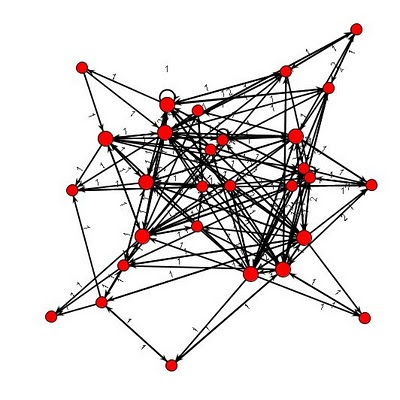 Many of us use learning management systems, and some of us even track students to support learning processes, but let's face it: tracking does not always result in clear visualization of the interactivity that is taken place amongst learners. Here is where SNAPP comes in.
Many of us use learning management systems, and some of us even track students to support learning processes, but let's face it: tracking does not always result in clear visualization of the interactivity that is taken place amongst learners. Here is where SNAPP comes in.There are other visual analyzing tools, but SNAPP is simple to use and easy to install, which is why I really like it.
SNAPP is developed by the University of Wollongong (who I think are coming up with a great deal of interesting educational innovations and thoughts). SNAPP allows you to transcript interactions in Moodle, Blackboard (and webCT, Desire2Learn into maps that immediately show who is a hyperconnected learner or participant, and who is more of a lurker, or even to pinpoint learners that at the core of the interactions.
SNAPP is a software tool that allows users to visualize the network of interactions resulting from discussion forum posts and replies. The network visualisations of forum interactions provide an opportunity for teachers to rapidly identify patterns of user behaviour – at any stage of course progression. SNAPP has been developed to extract all user interactions from various commercial and open source learning management systems (LMS) such as BlackBoard (including the former WebCT), and Moodle. SNAPP is compatible for both Mac and PC users and operates in Internet Explorer, Firefox and Safari.
By mapping interactions, you have a better overview of what people are doing and how they learn/perform. As such I see two fields of interest: education/training and knowledge management in corporations.
Education and training benefits
you can localize students or learners that are at risk (of not understanding, of having decreasingly less time...). The SNAPP-people have listed some great benefits of network diagrams:
* identify disconnected (at risk) students;
* identify key information brokers within your class;
* identify potentially high and low performing students so you can plan interventions before you even mark their work;
* indicate the extent to which a learning community is developing in your class;
* provide you with a “before and after” snapshot of what kinds of interactions happened before and after you intervened/changed your learning activity design (useful to see what effect your changes have had on student interactions and for demonstrating reflective teaching practice e.g. through a teaching portfolio)
* allow your students to benchmark their performance without the need for marking.
SNAPP also allows you to pinpoint lurkers (who might be a good target audience for research, e.g. did they get something out of the course, and why did they only lurk?
Additionally, you can filter out those students that might be good future facilitators. For students that are in the middle of the interactions, are clearly motivated and strong in reaching out and communicating.
Another educational benefit is for looking at peer-2-peer interactions. It might be that you do not get much feedback from a student, but after analyzing the interactions, you might see that that same student is a real peer-2-peer knowledge node, and as such has great course value.
Performance and knowledge management benefits
This SNAPP approach can also be used for knowledge management. Let's say you have a internal, central 'help' forum inside your company. And there is a person responsible for giving help on that forum. It might well be that after you screen the forum with SNAPP, you can see that someone else in your organization offers just as much help or support, just because they know the subject. As such you can give a bonus, or a different function to that active employee and stimulate knowledge transfer in your organization.
Interpretation of visual network maps
SNAPP does not simply provide the software, they also give an overview of how to interpret the visual data that you get from analyzing the network interactions.
So how does it work?
You download SNAPP and you get cracking with it!
I will take Moodle as an example:
Moodle
- Visit a Forum in Moodle. Ensure that “Display replies in nested format” is selected.
- Click on the SNAPP Bookmarklet (from where you placed it in the Bookmarks menu in Firefox or the Favorites menu in IE). You may need to enable the Menu bar in IE 7, to view the Favorites menu. The SNAPP interface will be inserted at the bottom of the page.
- The SNAPP interface consists of five tabs: Visualization, Statistics, Export, Help and Credits. Within the Export tab, social graph data can be saved as GraphML or to the .vna format. The .vna format can be opened in NetDraw for additional analysis and visualization.
Netdraw - also a free tool developed by Steve Borgatti a nice bearded bowling professor in Kentucky, allows you to fine-tune the graphs you get with SNAPP.
The picture depicted here is a representation of a welcoming forum in Moodle.